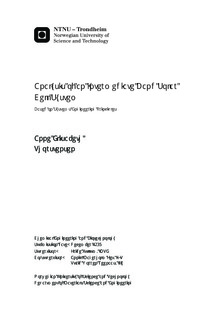Analysis of an Intermediate Band Solar Cell System: Based on Systems Engineering Principles
Abstract
The intermediate band solar cell (IBSC) is a so-called third generation solar cell, based on a new type of semiconductor materials; the intermediate band (IB) materials. In IB materials there is an additional intermediate energy band in the band gap of the semiconductor. Solar cells using such materials have an efficiency limit of 63 % in comparison to 41 % for solar cells made of conventional semiconductors. IBSCs have been attempted realized since 2001, based on toxic or non-abundant materials only. For sustainable development of IBSCs, it is important to identify materials and production routes that result in minimized environmental impacts.Two possible host materials for IBSCs were identified during a previous specialization project, and these were used as case materials to explore the challenges related to realization of sustainable IBSCs. This thesis describes the analysis of an IBSC system based on a ZnO/IB-Cu2O/Cu2O cell. The main objective was to analyze and optimize this intermediate band solar cell to determine if ZnO and Cu2O are promising IBSC materials. To get an overview of the functions and relationships of a complete IBSC system, a method combining the detailed materials technology field and holistic systems engineering process was utilized. This unusual combination and the fact that IBSCs are a relatively new and unexplored concept, resulted in a customized approach. Sustainable solutions for large-scale production of an IBSC system with focus on the cell structure and materials were found. Two cell cases were developed; an advanced cell with high quality materials and production, and one simple cell with a more conventional production route and less complex materials. The location of the desired IBSC system installation was set to a rooftop in Oslo, and a conventional photovoltaic (PV) system being planned there was used as an example. Desired and location-based performance parameters for an IBSC system located in Oslo were identified.A new approach that can solve combined materials technology and systems engineering assignments was developed. By utilizing this approach, challenges for ZnO and Cu2O as IBSC host materials were identified. These material challenges proved to be comprehensive, but might be overcome by customized growth of Cu2O single crystals to reduce resistivity, and tailoring the buffer layer and surface treatment at the ZnO/IB-Cu2O junction to reduce unwanted interface defects.
